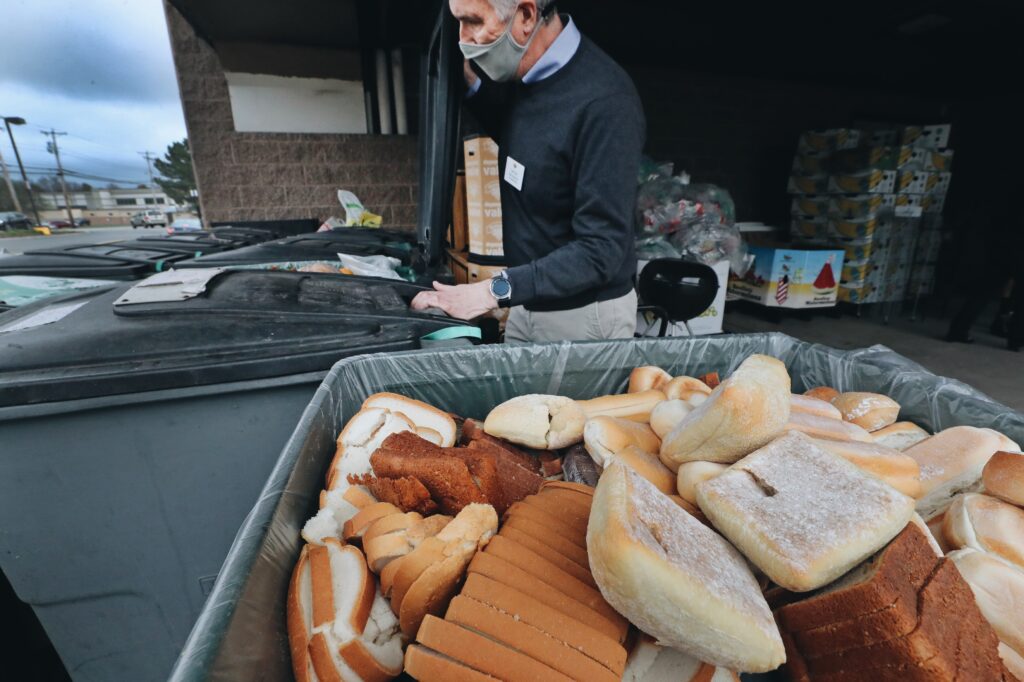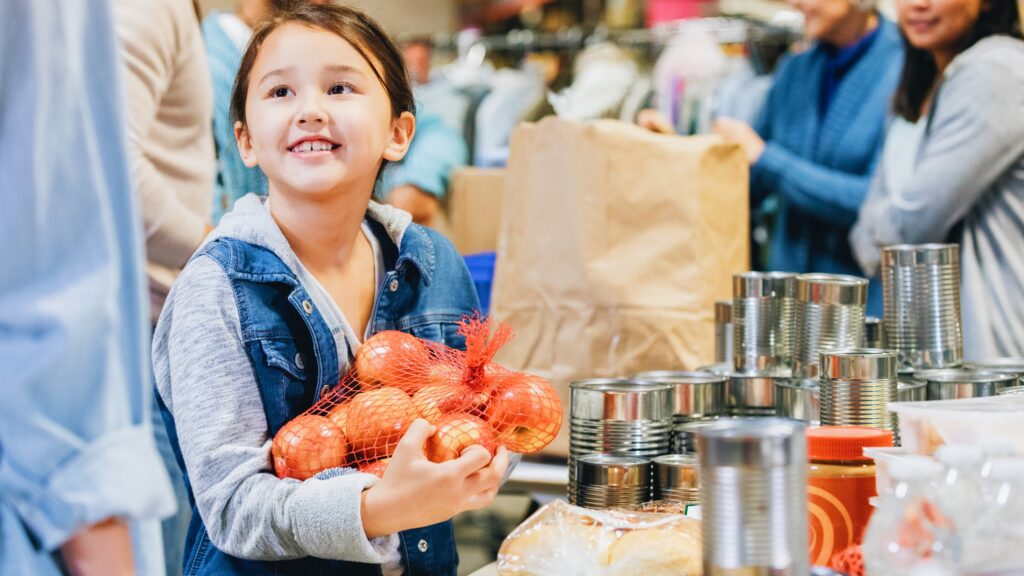Having a choice on what to eat for lunch, being able to easily access the ingredients to make it, having the financial resources to obtain it, and not worrying about how or what you are going to eat tomorrow or next week is a privilege. Food insecurity disproportionately affects Black and Latinx single-mother households and those living below the poverty line. In 2019, 9 million adults and 5.3 million children in the United States lived in food-insecure households. So how can we better understand food insecurity, and also be a part of solving it?

What Is Food Insecurity?
Food insecurity refers to living with that constant worry of not knowing what, how, or when an individual or family will have their next meal.This is an urgent public health crisis and racial justice issue that requires everyone’s attention. Even those not experiencing food insecurity likely know people who might be. Providing support to those experiencing food insecurity not only helps them, but it also strengthens our communities.
For Black, Latinx, and similarly historically marginalized groups, racial and economic inequality directly increase the risk of food insecurity in those communities. By becoming informed on how various forms of inequality deliberately determine who is food-insecure, and our role in perpetuating it, we can ultimately learn how to contribute to its prevention.

Who Experiences Food Insecurity?
According to the U.S. Department of Agriculture, food insecurity is defined as “a lack of consistent access to enough food for an active, healthy life.”
Even though it is often confused for hunger—weakness or discomfort felt as a result of a lack of food—food insecurity refers to the access to obtain food and the financial resources to afford it.
Findings from Feeding America’s “Hunger + Health” initiative revealed the characteristics of households with individuals and families who are considered to be food insecure. According to the USDA’s study on the various ranges of food insecurity, a significant percentage of households reported indicators of adults facing food insecurity.
Of these households, 97 percent reported feeling worried about their household food running out before having the income to purchase more. The same size group of adults reported that they often limited their food consumption by reducing meal sizes—or even skipping meals entirely due to a lack of financial resources available—with 89 percent of these adults reporting that this occurred in three or more months per year.
These lived experiences are very real and challenging uncertainties that people have always faced, but only recently began to be officially reported by the United States in the 1990s. In 2021, with the obstacles our country and world began to face in 2020 and continue to encounter due to the ongoing challenges of a public health crisis, food insecurity is at an all-time high.

How Did COVID-19 Affect Food Insecurity?
The food insecurity issues people were facing prior to the COVID-19 crisis were already significant and became even further exacerbated as a result of the pandemic, according to Feeding America.
With the highest unemployment rate we have seen in the U.S. since the Great Recession of 2007, this meant less income and inevitably even less food on the table for families. For children, the transition from in-person school to online learning meant the free lunches many depended on were harder to access, and in some cases, inaccessible. Over the course of 2020, about 15 million children, or 1 in 5 experienced food insecurity.
Before the COVID-19 pandemic, the rate of food insecurity in the United States was the lowest it had ever been in more than 20 years. Even though that may sound like a huge success, at least 1 in 9 adults and 1 in 7 children lived in a food-insecure household. In other words, about 35.2 million people, including 10.7 million children, were food insecure, according to findings from Feeding America’s Impact of the Coronavirus in 2020 & 2021 Report.

How Is Food Insecurity Influenced by Racial & Economic Inequality?
The pandemic is a clear testament of how people living above the poverty line are still at risk of becoming food insecure and how not all those living below the poverty line experience food insecurity. More often than not, there are additional factors, such as one’s racial background and socioeconomic status, that play a significant factor in determining its influence.
For Black, Latinx, and Native American communities, food insecurity is experienced at a much higher proportion due to discimination and structural racism. The disproportionate impact is evident when only 1 in 12 white individuals inhabit a food-insecure environment, while 1 in 4 Native American, 1 in 5 Black, and 1 in 6 Latinx individuals live in a food-insecure household.
Due to policies that have historically been enforced to keep BIPOC communities oppressed, it is evident how food insecurity is a racial equity issue. From having little to no economic opportunity by working in low-wage jobs, experiencing unemployment, and inequitable access to educational pathways or careers, BIPOC populations have been discriminated against and systematically trapped in poverty for generations.
The disparities are evident in poverty rates, the leading and root cause of food insecurity. While only 9.1 percent of white individuals experience poverty, roughly 15.7 percent of Latinxs and 18.8 percent of Black people live in poverty—about twice the amount of their white counterparts, revealing the obvious disparity that exists due to the influential role race relations and economic injustice has on food accessibility.

Who Is Affected by Food Insecurity?
Groups where food insecurity was higher than the national average includes all households with children which makes up about 14 percent, Latinx households at 16 percent, Black households at 19 percent, and most significantly, households with children headed by a single woman at 29 percent, according to data reported by the USDA.
When combined, many of these households are predominately Black and Latinx low-income households headed by a single woman. These low-income families of color are also affected by various overlapping issues and food insecurity is simply another addition to the list. There are intersectional issues BIPOC communities face, such as a lack of access to affordable housing, low wages, and greater health issues resulting in increased medical costs. From here we can conclude that food insecurity is not an isolated issue. There is a distinct connection between racial and economic inequalities, from a lack of access to financial resources and the everlasting impacts of the social determinants of health.
How Can We Prevent Food Insecurity?
Addressing the overlapping challenges and intersectional issues BIPOC communities face is an essential first step.
Due to the social determinants of health, it is vital to first understand the circumstances and reasons as to why food insecurity directly and most significantly impacts communities of color. These determinants include the conditions in the environments in which people are “born, live, learn, work, play, worship, and age that affect a wide range of health, functioning and quality-of-life outcomes and risks.”
Even though preventing food insecurity goes far beyond recognizing that it is an increasingly prevalent issue in America and across the globe, it is critical to formulate tangible solutions in determining our next steps. Taking action to mitigate our own impact on contributing to food insecurity requires us to:
Reduce Food Waste
About 1.3 billion tonnes of food is wasted globally, according to the Food and Agriculture Organization of the UN. Instead of wasting food as a result of overproduction and the decrease in financial resources available to pay for it, we must urge corporations and food service providers to donate excess foods to food banks, mutual aid groups, shelters, community programs, and others in need.
By throwing it away, this is not only wasting the food itself but also the amount of water and land resources that was used to produce it. The decisions and actions made by retailers, food service providers, and consumers should be in the interest of the public good, not for the profit of corporations.
Learn more about food waste and how to prevent it here.
Advocate for Climate Justice
As the climate crisis continues to evolve, the shifting climatic patterns directly affect agricultural production, availability, access, quality, and the stability of our global food systems.
Similarly, weather-related disasters, and even lack thereof such as droughts, continuing to rise effectively reduces the yields of major crops we use in our staple foods. Lastly, when referring to the nutritional value of crops, the increase in CO2 levels reduces the amount of nutrition our crops carry and further contributes to the malnutrition, lack of diet diversity, and rise of health effects.
To combat the effects of climate change, we must first take responsibility for both mitigating the causes of the climate crises and focus on supporting low and middle-income communities who are most directly impacted by its effects.
Support Plant-Based Agricultural Food Systems
Reducing the consumption of meat and other animal products and transitioning to plant-based eating can have an immensely positive impact on the availability of food. The impact of plant-based foods—and a global shift to plant farms instead of animal agriculture—will result in a significant decrease in food insecurity.
Since plant-based alternatives require less agricultural land use than beef, pork, dairy, or poultry, this would give us the opportunity to provide more agricultural systems that do not require excessive use of land or resources—such as water or production of crops used for livestock—that could be preserved for global human consumption to eliminate world hunger.
Not only is animal agriculture a threat to the health of our humanity as it increases the risk of diseases and various forms of cancer, it is a driving force behind the climate crisis. It further contributes to food insecurity as it results in the loss of biodiversity, depletion of freshwater supplies, and stress on food-producing systems.
Ultimately, this will allow for the production of more food to feed populations overall. When we shift from our traditional food systems and intake and transition to plant-based agricultural systems, the amount of communities experiencing food insecurity drastically decreases.
Support BIPOC Farms and Community Nonprofits Fighting for Food Equity
The American Rescue Act of 2021, signed by President Joe Biden promises not just financial relief to BIPOC farming and food businesses, but a historic relief package designed to serve as reparations for Black farmers.
Across the country, there are Black-led organizations committed to Black liberation and food justice by striving towards equity to preserve sustainable, vegan food systems.
The National Black Food and Justice Alliance is devoted to serving Black urban and rural farmers and organizers by creating an intergenerational movement to protect Black land and work towards food sovereignty. This alliance is made up of a variety of organizations, such as the Black Church Food Security Network which serves to connect churches to Black-led farms, including plant-based ones, across the country from Texas to Massachusetts.
We can all have a significant impact in combating the food insecurity crisis by supporting local and national organizations working at the intersection of food justice, climate justice, and plant-based eating.
With organizations such as A Well-Fed World leading the way, an international food security organization advancing plant-based foods and farming, supporting these efforts and joining the movement for change is vital to attaining food security. To learn more about how food insecurity impacts various populations and groups in your congressional district, state, and even county, utilize Feeding America’s “Map the Meal Gap” interactive tool.
Food insecurity is an ongoing issue communities across America and the globe endure. Together, we can work to implement community-based solutions that meet the needs and unique challenges BIPOC communities encounter, contribute to the reduction of food waste to eventually eliminate it entirely, and join the fight for racial, economic, and climate justice as engaged global citizens that recognize the unique privilege that is food security.


